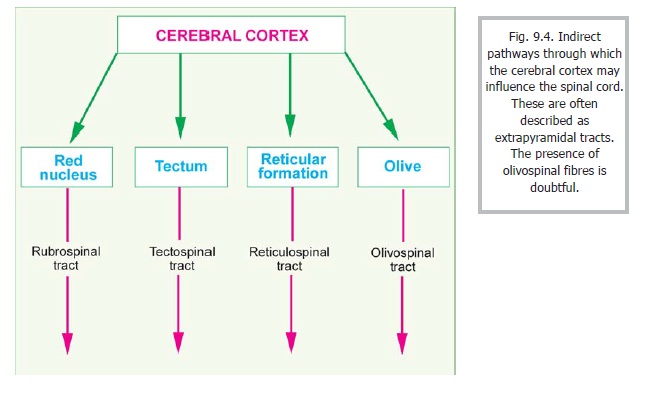Chapter: Human Neuroanatomy(Fundamental and Clinical): Tracts of Spinal Cord and Brainstem
Descending Tracts ending in the Brainstem
Descending Tracts ending in the Brainstem
Corticonuclear tracts
The nuclei of cranial nerves that supply skeletal muscle (i.e., somatic efferent and special visceral efferent nuclei) are functionally equivalent to ventral horn cells of the spinal cord. They are under cortical control through fibres that are closely related in their origin and course to corticospinal fibres. At various levels of the brainstem these fibres cross to the opposite side to end by synapsing with cells in cranial nerve nuclei, either directly or through interneurons.
Cortico-ponto-cerebellar pathway
Fibres arising in the cerebral cortex of the frontal, temporal, parietal and occipital lobes descend through the corona radiata and internal capsule to reach the crus cerebri. The frontopontine fibres occupy the medial one sixth of the crus; and the temporopontine fibres (along with occipitopontine and parietopontine fibres) occupy the lateral one sixth of the crus (Fig. 11.8). These fibres enter the ventral part of the pons to end in pontine nuclei of the same side.
Axons of neurons in the pontine nuclei form the transverse fibres of the pons. These fibres cross the middle line and pass into the middle cerebellar peduncle of the opposite side. The fibres of this peduncle reach the cerebellar cortex.
The cortico-ponto-cerebellar pathway forms the anatomical basis for control of cerebellar activity by the cerebral cortex.
Other fibres ending in the Brainstem
The cerebral cortex also exercises control on various masses of grey matter (other than cranial nerve nuclei and pontine nuclei) of the brainstem. Fibres from the cortex end in the red nucleus, the tectum, the substantia nigra, the inferior olivary nucleus (?), the interstitial nucleus and the reticular formation. These centres can also be influenced by the cortex indirectly through the striatum (caudate nucleus and putamen of lentiform nucleus) and the globus pallidus (Figs 9.4, 9.5). In turn these centres influence the spinal cord directly through tracts descending from them (rubrospinal, tectospinal, olivospinal, reticulospinal); and indirectly through the reticular formation and the reticulospinal tracts. These connections are often described as part of the extrapyramidal pathways referred to above.


Related Topics